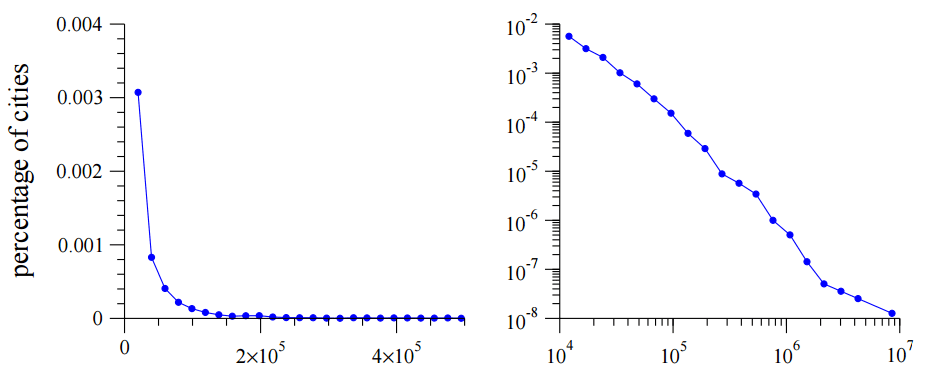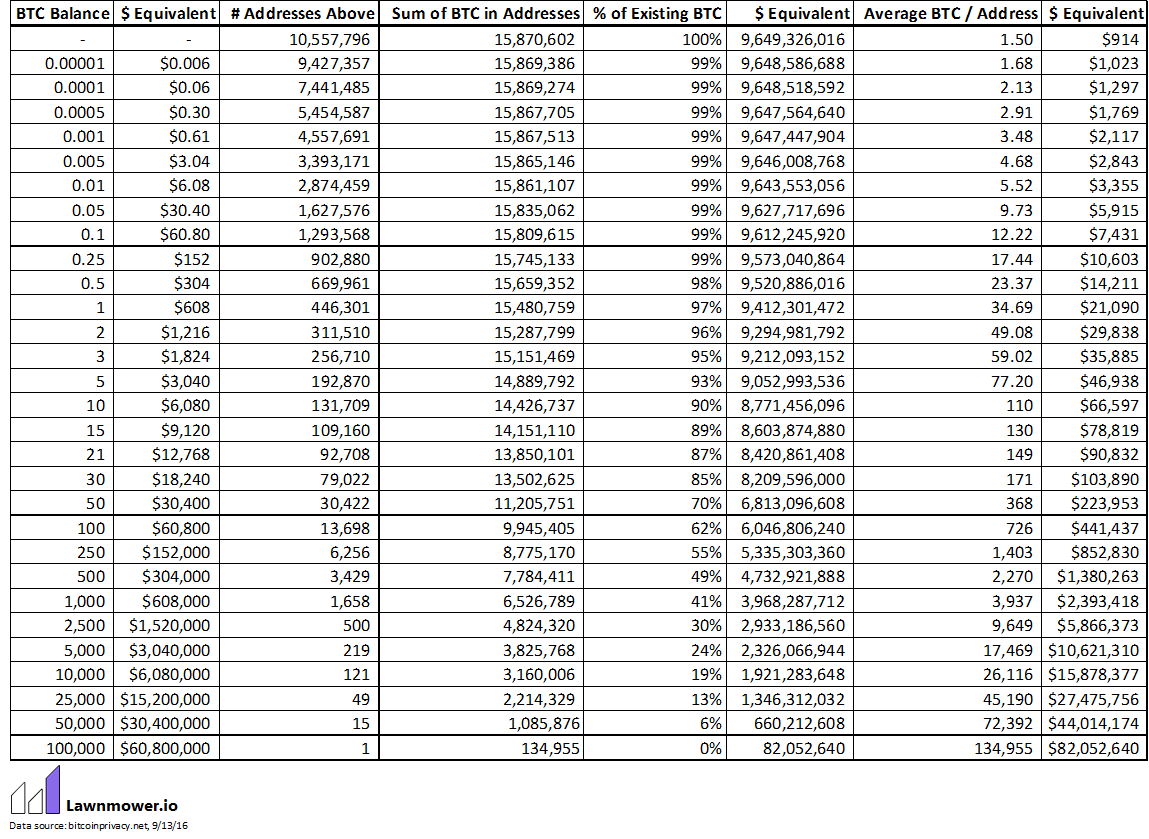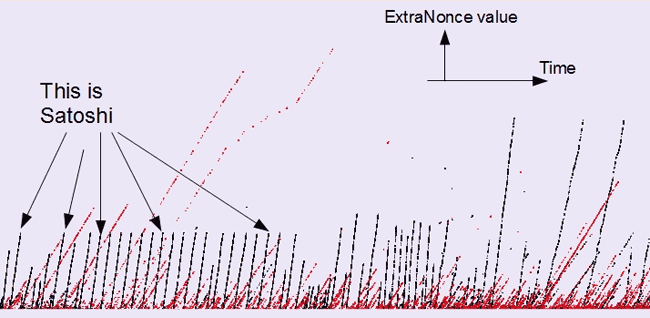The distribution of bitcoins is also subject to a power law
The Pareto distribution in probability theory is a two-parameter family of absolutely continuous distributions that are power law. When the probability of obtaining one or another value is inversely proportional to some degree of this value, then this value is characterized by a power law. Simply put, this is one of the main mathematical laws of our life. It looks like this:
Power laws are often found in physics, biology, earth sciences, space, economics, finance, computer science, demography, and other social sciences [see Guerriero, V. (2012). "Power Law Distribution: Method of Multi-scale Inferential Statistics". Journal of Modern Mathematics Frontier (JMMF), 1: 21-28. , as well as "MEJ Newman Power laws, Pareto distributions and Zipf's law" ].
The extent of craters on the moon, the population of cities on earth, the strength of earthquakes, the size of computer files, the scale of military conflicts, the frequency of words in any human language, the frequencies of surnames in most cultures, the sale of products of almost any category with many brands, the number of species in biological kind, the number of articles written by scientists, the number of links to web pages.

Histograms of US settlements by the number of inhabitants (the number of inhabitants is plotted along the abscissa)
')
And of course, the distribution of people's welfare is subject to a power law.
Italian engineer and economist Wilfredo Pareto developed his theory initially to describe the distribution of wealth, as well as the distribution of people's income in society. According to Pareto, society has a pyramidal structure, on top of which is the elite - the leading social stratum, guiding the life of the whole society. In his works, Pareto was skeptical of democratic regimes. The scientist believed that in political life there is a universal law in which the elite always deceive the masses.
In one of his works, Wilfredo Pareto noted that 20% of Italian households receive 80% of their income. Although the scientist died in 1923, in 1941 they decided in his honor to call the so-called "Pareto's law" that 20% of labor implements 80% of the result, but the remaining 20% of the result requires 80% of the total costs. As you can see, the Pareto distribution and power laws again showed themselves.
If we assume that the distribution of welfare in society is subject to a power law, then we indirectly confirm the validity of the theory of elites, which Pareto himself spoke about.
One way or another, but capitalist Western society fully demonstrates the validity of this theory. The well-being of people is really subject to a power law. We can get the most graphic confirmation of this if we study the distribution of bitcoins among wallets .
The blockchain allows you to examine in detail the path of each coin: to fix, when it appeared, what wallets went through and in which wallet it is now. Due to the anonymous nature of the system, we cannot conclude about the number of users of the system or the welfare of each of them, but the distribution of coins among the wallets is shown in the most accurate way.

In absolute figures, the following picture is obtained:
 7.4 million addresses with a balance> 0.0001 BTC ($ 0.06)
7.4 million addresses with a balance> 0.0001 BTC ($ 0.06)
4.5 million addresses with a balance of> 0.001 BTC ($ 0.61)
2.8 million addresses with a balance> 0.01 BTC ($ 6.08)
1.2 million addresses with a balance> 0.1 BTC ($ 60.80)
446 301 address with balance> 1 BTC ($ 608)
131 709 addresses with a balance> 10 BTC ($ 6080)
13,698 addresses with a balance> 100 BTC ($ 60,800)
1658 addresses with a balance> 1000 BTC ($ 608,000)
121 address with balance> 10,000 BTC ($ 6,080,000)
1 address with a balance> 100,000 BTC ($ 60,800,000)
Detailed statistics are given in the table.

There is almost a perfect power distribution.
As already mentioned, the number of Bitcoin users cannot be judged by the number of wallets. One person can own many wallets. Conversely, a group of individuals (or a legal entity) may jointly own one purse with a large amount.
Nevertheless, based on other indirect evidence, it can be concluded that approximately 7 million people used Bitcoins all over the world. True, the total number of users can be blurred in time. Some researchers assume that up to 30% of existing Bitcoin users are “zombies” who have lost their private keys and access to cash. The fate of Satoshi Nakamoto, who namainil a million coins on his personal computer at the dawn of the formation of the system, is also unknown .
As the investigation showed, from January 3, 2009 to January 25, 2010, only one person was engaged in bitcoin mining, and the absolute majority of the coins mined at that time are still kept by him.

The black and red colors indicate the generation and waste of coins in the interval between blocks 1 and 36288
Of course, it is impossible to say 100% that the coins generated at first belong to Satoshi, but the fact is that someone started mining from the first block and continued it for a whole year at a stable speed of about 7 megabytes per second , with short pauses approximately every 100 hours presumably for backing up the wallet.
It is estimated that in the first few months Satoshi produced about 1 million coins, which is about $ 602 million at the current exchange rate.
p (x) = Cx -m
Power laws are often found in physics, biology, earth sciences, space, economics, finance, computer science, demography, and other social sciences [see Guerriero, V. (2012). "Power Law Distribution: Method of Multi-scale Inferential Statistics". Journal of Modern Mathematics Frontier (JMMF), 1: 21-28. , as well as "MEJ Newman Power laws, Pareto distributions and Zipf's law" ].
The extent of craters on the moon, the population of cities on earth, the strength of earthquakes, the size of computer files, the scale of military conflicts, the frequency of words in any human language, the frequencies of surnames in most cultures, the sale of products of almost any category with many brands, the number of species in biological kind, the number of articles written by scientists, the number of links to web pages.

Histograms of US settlements by the number of inhabitants (the number of inhabitants is plotted along the abscissa)
')
And of course, the distribution of people's welfare is subject to a power law.
Italian engineer and economist Wilfredo Pareto developed his theory initially to describe the distribution of wealth, as well as the distribution of people's income in society. According to Pareto, society has a pyramidal structure, on top of which is the elite - the leading social stratum, guiding the life of the whole society. In his works, Pareto was skeptical of democratic regimes. The scientist believed that in political life there is a universal law in which the elite always deceive the masses.
In one of his works, Wilfredo Pareto noted that 20% of Italian households receive 80% of their income. Although the scientist died in 1923, in 1941 they decided in his honor to call the so-called "Pareto's law" that 20% of labor implements 80% of the result, but the remaining 20% of the result requires 80% of the total costs. As you can see, the Pareto distribution and power laws again showed themselves.
If we assume that the distribution of welfare in society is subject to a power law, then we indirectly confirm the validity of the theory of elites, which Pareto himself spoke about.
One way or another, but capitalist Western society fully demonstrates the validity of this theory. The well-being of people is really subject to a power law. We can get the most graphic confirmation of this if we study the distribution of bitcoins among wallets .
The blockchain allows you to examine in detail the path of each coin: to fix, when it appeared, what wallets went through and in which wallet it is now. Due to the anonymous nature of the system, we cannot conclude about the number of users of the system or the welfare of each of them, but the distribution of coins among the wallets is shown in the most accurate way.

In absolute figures, the following picture is obtained:
 7.4 million addresses with a balance> 0.0001 BTC ($ 0.06)
7.4 million addresses with a balance> 0.0001 BTC ($ 0.06)4.5 million addresses with a balance of> 0.001 BTC ($ 0.61)
2.8 million addresses with a balance> 0.01 BTC ($ 6.08)
1.2 million addresses with a balance> 0.1 BTC ($ 60.80)
446 301 address with balance> 1 BTC ($ 608)
131 709 addresses with a balance> 10 BTC ($ 6080)
13,698 addresses with a balance> 100 BTC ($ 60,800)
1658 addresses with a balance> 1000 BTC ($ 608,000)
121 address with balance> 10,000 BTC ($ 6,080,000)
1 address with a balance> 100,000 BTC ($ 60,800,000)
Detailed statistics are given in the table.

There is almost a perfect power distribution.
As already mentioned, the number of Bitcoin users cannot be judged by the number of wallets. One person can own many wallets. Conversely, a group of individuals (or a legal entity) may jointly own one purse with a large amount.
Nevertheless, based on other indirect evidence, it can be concluded that approximately 7 million people used Bitcoins all over the world. True, the total number of users can be blurred in time. Some researchers assume that up to 30% of existing Bitcoin users are “zombies” who have lost their private keys and access to cash. The fate of Satoshi Nakamoto, who namainil a million coins on his personal computer at the dawn of the formation of the system, is also unknown .
As the investigation showed, from January 3, 2009 to January 25, 2010, only one person was engaged in bitcoin mining, and the absolute majority of the coins mined at that time are still kept by him.

The black and red colors indicate the generation and waste of coins in the interval between blocks 1 and 36288
Of course, it is impossible to say 100% that the coins generated at first belong to Satoshi, but the fact is that someone started mining from the first block and continued it for a whole year at a stable speed of about 7 megabytes per second , with short pauses approximately every 100 hours presumably for backing up the wallet.
It is estimated that in the first few months Satoshi produced about 1 million coins, which is about $ 602 million at the current exchange rate.
Source: https://habr.com/ru/post/372705/
All Articles